In this article, we will attempt to cover every possible subject involved in the tuning of a Banjo Ukulele.
This includes soprano, concert, tenor as well as baritone Banjo ukes; tuning by ear or with electric tuner; and any other related topic someone might be looking for.

So grab your banjolele, do your best imitation of a George Formby grin, and let’s get right to it:
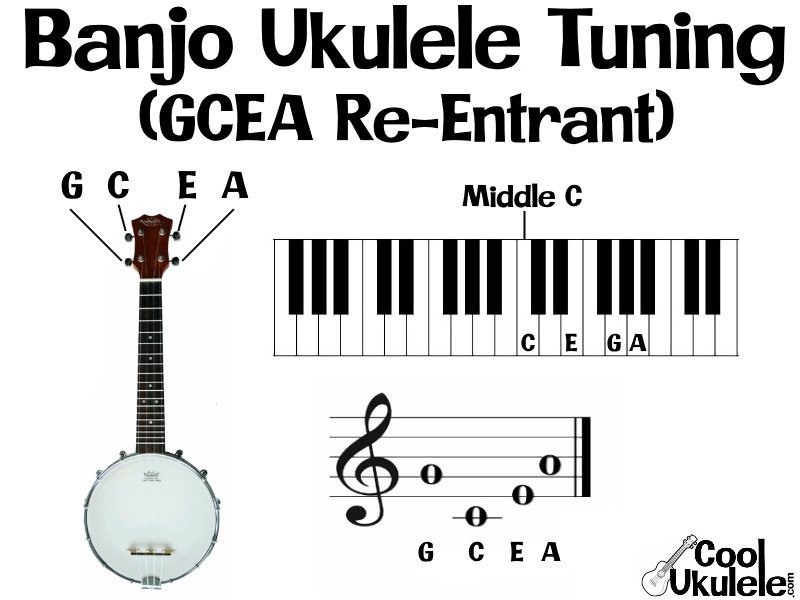
How are Banjo Ukuleles Tuned?
Banjo Ukuleles are tuned identically to their standard ukulele counterparts. This means that soprano, concert, and tenor banjo ukes are tuned to g-C-E-A tuning, with a high G-string. Baritone banjoleles, also like their standard cousins, are tuned with D-G-B-E tuning, with a low D-string.

Banjo Ukulele Tuning, The Deep Dive:
Step-by-Step Banjolele Tuning
- Banjolele Tuning with Online Reference Notes
- How to Tune a Banjo Ukulele by Ear
- How to Tune A Baritone Banjo Uke By Ear
- How to Tune a Banjo Ukulele with an Electronic Tuner
Banjo Uke Tuning History
Banjo and Standard Ukulele Tuning Comparison
Other Banjo Ukulele Tuning Topics
- Can I Tune my Banjolele with Low-G Tuning?
- Can I Tune my Baritone Banjo Uke with Re-entrant Tuning?
- How are 8-String Banjo Ukuleles Tuned?
- How Do I Tune A 6-String Banjo Ukulele?
- Do Banjo Ukuleles and Regular Ukuleles Use Different Strings?
- Can I Put Steel Strings On My Banjolele?
- What are the Banjo Ukulele Tuning Notes?
- How Do The Different Tuning Systems Effect the Banjo Ukulele’s Fret-Board Notes?
- What are The Common Chords on a Tuned Banjo Uke?
- What are the Frequencies Used for Tuning a Banjolele?
- 4-String Banjo Ukulele Tuning
- How are Soprano, Concert, and Tenor Banjo Ukuleles Tuned?
- What Are The Approximate String Tensions of Banjo Ukulele Strings When Tuned?
- Tuning a Banjo Ukulele’s Drum Head
Banjolele Tuning Mechanisms and Conclusion
Banjolele Tuning with Online Reference Notes
Here’s a video which plays the different pitches of GCEA ukulele tuning:
Don’t worry that its not a banjo ukulele, the pitches are the same.
To tune your strings to the pitches in the video, start by loosening all the strings so they are tuned lower than the desired pitch.
Next, tighten each string as its pitch is played in the video until the strings sound (pitch) “matches” the sound of the string in the video. You’ll know when the two strings are in tune because they will sound like they echo each other with no “warble”, if that makes sense.
How to Tune a Banjo Ukulele by Ear (With a C Reference Note)
- TUNE YOUR C STRING
Grab your soprano, concert, or tenor banjo uke and identify the thickest string, 3rd from the bottom.
Tune it to middle C from another source by starting with a loose string and tightening it until the string’s tone matches the source’s tone (you’ll know the tones are matched when you don’t hear any “warble” of the two sounds when they are heard at the same time). - TUNE YOUR E STRING
Hold down the now-tuned 3rd C string at the fourth fret and tune the 2nd (E) string until it matches using the above method. - TUNE YOUR G STRING
Now to tune your G (fourth) string, hold your E string at the 3rd fret and match the top (G) string to it, again using the above method - TUNE YOUR A STRING
Finally, play your fourth (G) string at the second fret and match your first (A) string to the sound.
Congratulations, you are now ready to start strumming!
How to Tune A Baritone Banjolele By Ear (With a D Reference Note)
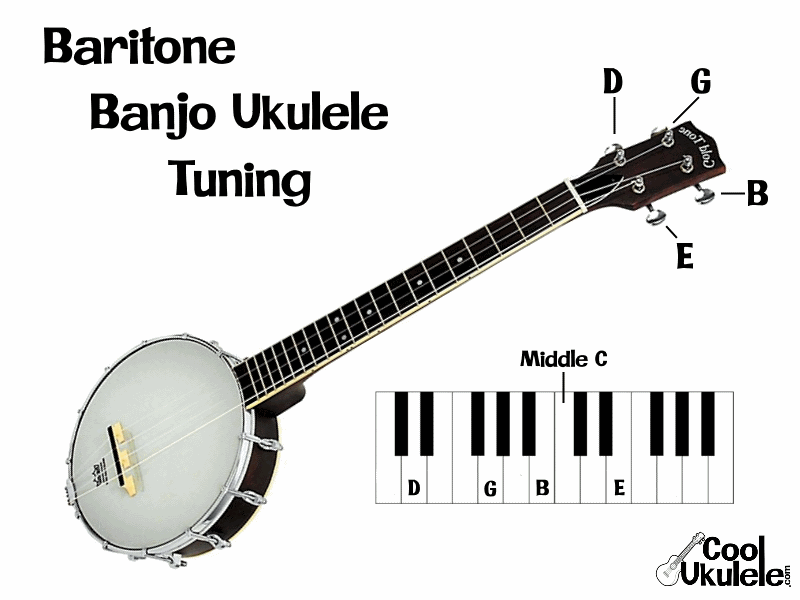
- TUNE YOUR D STRING
First grab your Baritone-sized Banjolele (don’t hurt your back!) and identify the 4th from the bottom (thickest) string. This is your D string.
Find a source (keyboard, tuning fork, etc.) for the D below middle C and tune this string to that source.
To tune the string, start with it loose and slowly tighten it and play both the string and source until the two sounds match (you’ll know the tones are matched when you don’t hear any “warble” of the two sounds when they are heard at the same time) - TUNE YOUR G STRING
Hold down your now-tuned D string at the 5th Fret and pluck it. Now tune your 3rd (G) string to the sound produced by the plucking using the same method from step 1. - TUNE YOUR B STRING
Now, to tune your B string, hold your G string down on the 4th fret and tune your 2nd (B) string to it using the same method as step 1 and 2. - TUNE YOUR E STRING
Finally, pluck your B string after holding it at the 5th fret and tune your 1st (E) string to it.
Congratulations, you have now tuned your Baritone Banjo Ukulele and you are now ready to start strumming!
For more information specifically on Baritone Uke Tuning, check out the Baritone Ukulele Tuning article!
How Do I Tune a Banjo Ukulele with an Electronic Tuner?
An electric tuner is an device which “listens” to sounds and tells you the note which is being played.
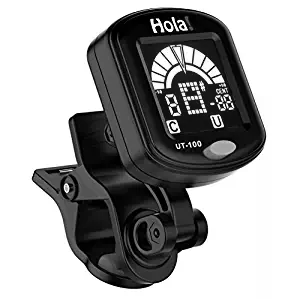
The exact usage of your specific model of electronic tuner depends on its specific functions and features.
Tuning a Soprano, Concert, or Tenor Banjo Ukulele with an Electronic Tuner
To tune your soprano, concert, or tenor banjo uke with an electronic tuner, start with tuning your 3rd from bottom (thickest) string to Middle C (around 261.63 Hz).
Next, tune your E (2nd from bottom) string to the E above that.
Now, tune your G string (4th from bottom) to the G above that E.
And finally, tune your A string (bottom) to the A above that G.
Tuning a Baritone Banjo Ukulele with an Electronic Tuner
To tune your baritone banjo ukulele with an electronic tuner, start by tuning your D string (4th from bottom) to the D below middle C.
Next tune your G string (3rd from bottom) to the G above that D.
Now tune your B string to the G above that.
And finally tune your E string to the E above that G.
Banjo Ukulele Tuning Origins
The origins of the tuning systems used for Banjo Ukes are really just extensions of the origins of the Banjo Ukulele itself.
Back in the days of vaudeville, before the invention of modern amplification, ukulele performers needed a louder instrument to be heard. Though we’re not exactly sure who, someone had the bright idea to use a banjo body to achieve the greater sound volume and thus the banjolele was born!

Because the banjo ukulele was just a regular ukulele with a banjo body, it adopted the same sizes and tuning systems as the original ukulele. The tuning systems of the original ukulele were themselves adapted from earlier small, Portuguese instruments in the guitar/lute family.
Are Banjoleles and Regular Ukuleles Tuned the Same?
Yes. Because the banjo ukulele was developed as basically a louder version of the original wood-body ukulele, it uses the same standard tuning systems for each size of ukulele as regular ukuleles.
Are Banjolele and Ukulele Chords the Same?
Yes. Because Banjo and regular ukuleles traditionally share the same standard tuning systems, they also share the same chords and chord shapes.
Any chords you have learned on a regular Ukulele should also work on your Banjo uke. Two for one!
Can I Tune my Banjolele with Low-G Tuning?
Yes. You will need to replace your top string (fourth from bottom) with a thicker string made for the lower note, but you can absolutely use low-G tuning on a soprano, concert, or tenor Banjo Ukulele.
For more information about Low G tuning and how it compares to re-entrant High G tuning, check out our Ukulele Low G vs. High G – The Tuning Tango article.
Can I Tune my Baritone Banjo Uke with Re-entrant Tuning?
Yes. Though you will need to replace your top (D) string with a thinner string to get the higher note.
If you want to use g-C-E-A re-entrant tuning, you might need to change all four strings to tune to the higher notes without over-tightening your strings.
This will likely give the instrument a brighter, more stereotypical ukulele sound when strummed.
How are 8-String Banjo Ukuleles Tuned?
Most popular 8-string instruments are tuned as 4-string instruments with each string in doubled pairs.
The 8-string banjolele is no exception. The standard tuning notes for soprano, concert, and tenor 8-string banjo ukes are G-G-C-C-E-E-A-A. For Baritones, the standard pairs are D-D-G-G-B-B-E-E.
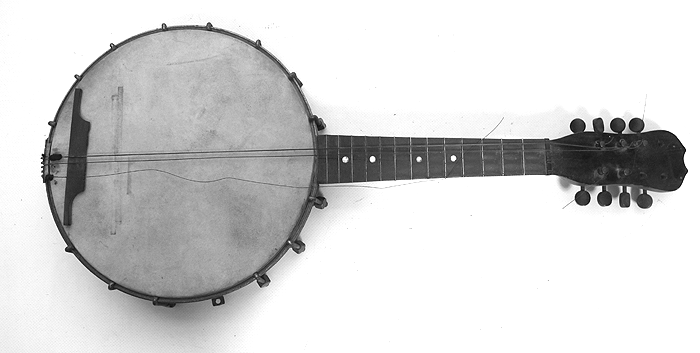
To tune an 8-string banjo ukulele, follow the instructions above, only tune each pair of strings together, each string with its double.
How Do I Tune A 6-String Banjo Ukulele?
6 String Ukuleles are typically tuned by doubling up the lowest and highest strings.
So for soprano, concert, and tenor banjoleles, which are traditionally tuned with GCEA tuning, the 6-string counterpart would be GCCEAA, doubling the (lowest) C string and the (highest) A string.
For a 6-string baritone Banjo uke, you would tune it to DDGBEE, as the 4-string counterpart is tuned to DGBE. This doubles the D (lowest) string and the E (highest) string.
Do Banjo Ukuleles and Regular Ukuleles Use Different Strings?
Nope. The standard Banjolele does not require special strings. It uses the same nylon strings as a regular all-wood-bodied ukulele.
So feel free to put your extra strings from your other ukuleles on your banjo uke and tune ’em up!
Can I Put Steel Strings on My Banjolele?
No! The banjo ukulele body is not built to hold the higher tension of steel strings. This could severely damage your precious instrument and should not be attempted.
Remember: a broken ukulele is a sad ukulele!
What are the Banjo Ukulele Tuning Notes?
The standard tuning notes for soprano, concert, and tenor banjo ukes are G, C, E, and A. The tuning notes traditionally used for baritone banjoleles are D, G, B, and E.
How Do The Different Tuning Systems Effect the Banjo Ukulele’s Fretboard Notes?
The following images show the Fretboard notes of the two most common tuning systems used for Banjo ukes.
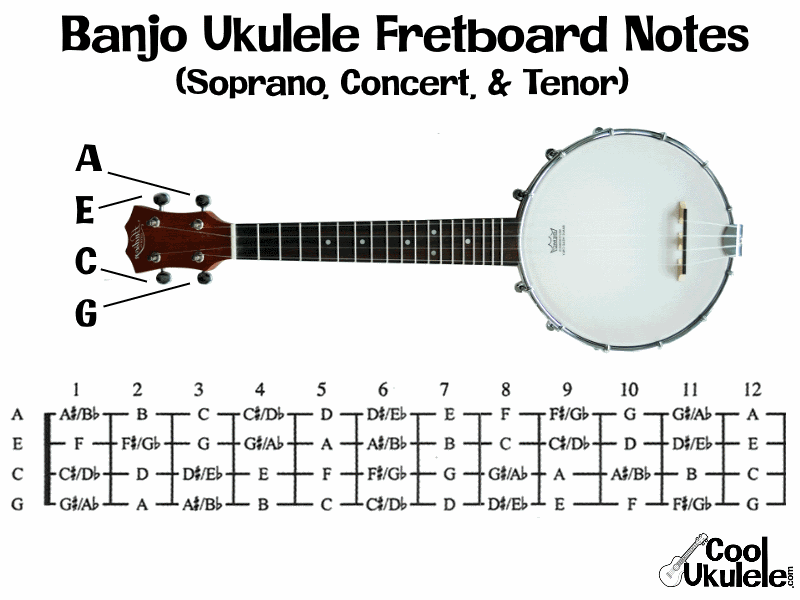

What are The Common Chords on a Tuned Banjo Uke?
The following are chord charts of common chords played on the banjo ukulele:
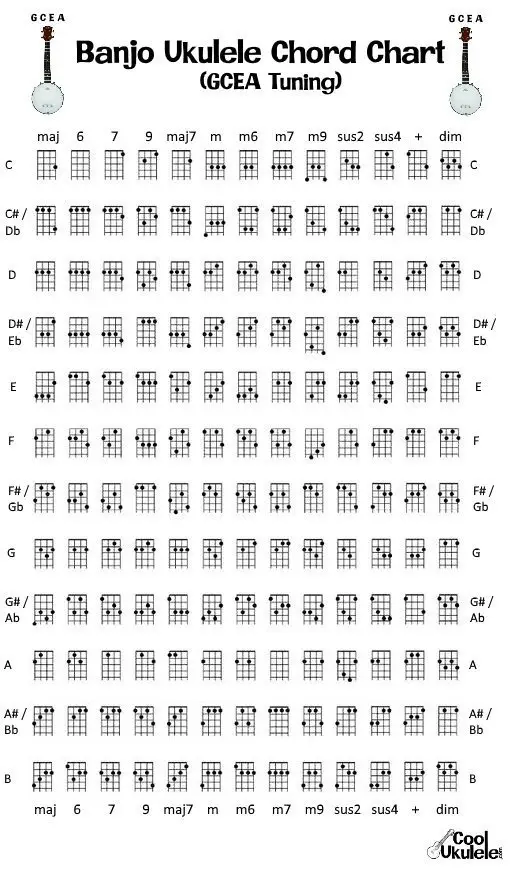
And here’s the Baritone (DGBE) Banjo Ukulele Chord Chart:
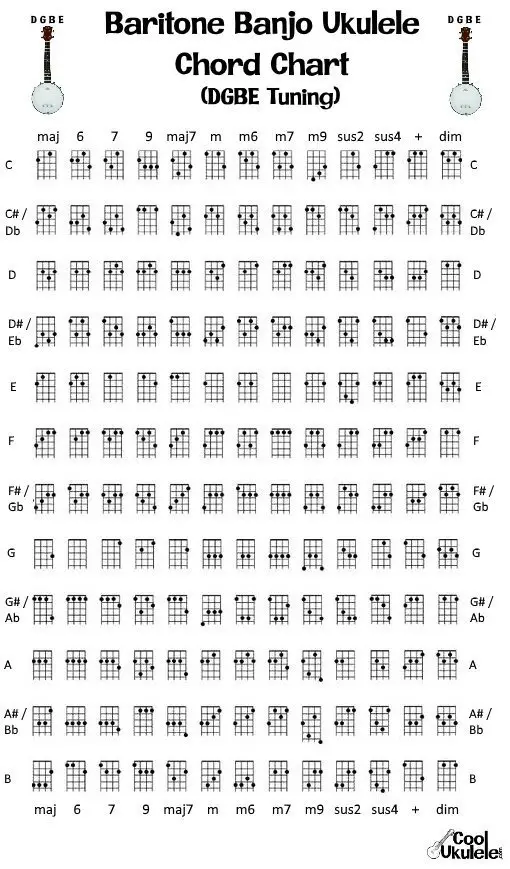
How are Soprano, Concert, and Tenor Banjo Ukuleles Tuned?
Soprano, Concert, and Tenor Banjoleles are traditionally tuned similarly to standard Ukulele counterparts. All three traditionally use G-C-E-A tuning, where C is middle C and the G, E, and A are those notes just above middle C.

What are the Frequencies Used for Tuning a Banjolele?
High G Banjolele Tuning Frequencies
For soprano, concert, and tenor banjo ukes in tuned in re-entrant C (high G string), the standard frequencies (equal temperament) used are:
| Uke String | Tuning Frequency |
|---|---|
| G4 (High G) | 392 Hz |
| C4 | 261.63 (often rounded to 262) Hz |
| E4 | 329.63 (often rounded to 330) Hz |
| A4 | 440 Hz |
Low G Banjolele Tuning Frequencies
For soprano, concert, and tenor banjo ukes in linear C tuning (with a low G string), the standard frequencies (equal temperament) used are:
| Uke String | Tuning Frequency |
|---|---|
| G3 (Low G) | 196 Hz |
| C4 | 261.63 (often rounded to 262) Hz |
| E4 | 329.63 (often rounded to 330) Hz |
| A4 | 440 Hz |
Baritone Banjolele Tuning Frequencies
For Baritone Banjo Ukuleles tuned to linear G tuning, the standard frequencies (equal temperament) used are:
| Uke String | Tuning Frequency |
|---|---|
| D | 146.83 (often rounded to 147) Hz |
| G | 196 Hz |
| B | 246.94 (often rounded to 247) Hz |
| E | 329.63 (often rounder to 330) Hz |
4-String Banjo Ukulele Tuning
Soprano, Concert, and Tenor 4-string Banjoleles are traditionally tuned to g-C-E-A with a high G string (re-entrant). Baritone 4-String Banjo Ukes are traditionally tuned to D-G-B-E with a low D string (not re-entrant).
As four strings is the standard on banjo ukes, see above to learn how to tune a 4-string banjo ukulele.
What Are The Approximate String Tensions of Banjo Ukulele Strings When Tuned?
As Banjo Ukuleles use nylon strings are smaller than regular Banjos or Guitars, the string tension is much lower. Here’s a table of the approximate string tensions of the different sized banjo Ukuleles:
| Ukulele Type | String Tension |
|---|---|
| Soprano Banjo Uke | Around 33 lbs. |
| Concert Banjo Uke | Around 35 lbs. |
| Tenor Banjo Uke | Around 39 lbs. |
| Baritone Banjo Uke | Around 53 lbs. |
| 6-String Tenor Banjo Uke | Around 65 lbs. |
| 8-String Tenor Banjo Uke | Around 83 lbs. |
Notice the Larger the instrument, the more tension its strings have. And also: the more strings, the higher the tension.
To compare to guitar: Nylon-string Guitars have a round 80-85 lbs. of tension, while Steel-string guitars have upwards of 200 lbs of tension.
Tuning a Banjo Ukulele’s Drum Head
Your Banjo Uke should have a mechanism for tightening and loosening the drum head. It is generally not considered necessary to tune the drum head to a specific note, though I have heard of it.
A tighter drum head will give you a brighter sound while a looser drum head will generally give a deeper, more “warbly” sound. Experiment and see what you prefer for your specific instrument and sound preference, but be sure not to over-tighten the head and risk damaging your instrument. null
Geared Tuners or Friction Tuners for a Banjolele?
Geared Tuners (also called Machine Head Tuners) are tuners which hold strings in tune through a pair of gears. One gear is on the shaft to which the string is mounted, the other is on a perpendicular shaft which connects to a tuner head which is turned to tighten or loosen the string:
Geared tuners are available as both Open and Sealed.
With Open Geared Tuners, the gears are exposed which allows for easier adjustments and cleaning, but also means they require more cleaning.

Sealed Geared Tuners, on the other hand, are housed in a casing so the gears can’t be seen or easily accessed. The advantage here is that the gears won’t need to be cleaned as often, but they will be more difficult to clean and adjust if it does become necessary.
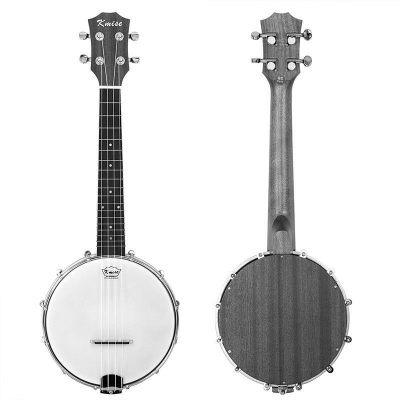
Friction Tuners, on the other hand, hold the string with friction (shocking!) on a single shaft which connects the string-holding part of the tuner to the turn-able tuning head:
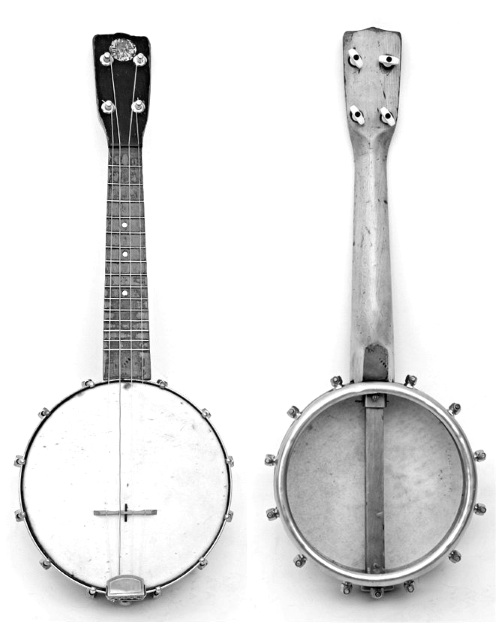
Friction tuners will usually have a screw on each peg which adjusts the “hold” or friction of the peg. The tighter the screw, the better the string will keep in tune, but also the more difficult it is to adjust the peg.
Generally, friction tuners will stick out behind the head-stock of the ukulele and geared tuners will stick out on the sides. The most common exception will be friction tuners on a cutout head-stock as seen here:
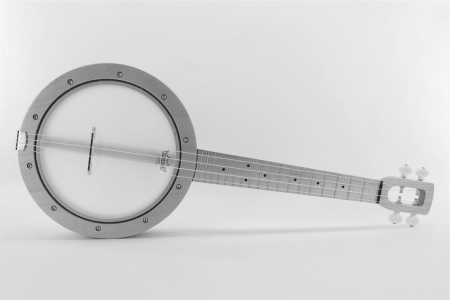
The advantage to friction tuners is that they are easier for making larger adjustments to the tightness of a string, while geared tuners are better at fine-tuning a string’s tightness.
I personally go back and fourth on preferring geared or friction tuners, but, as long as they are high-quality, you should be fine with either system.
On Banjo Ukulele Tuning Pegs
Banjo ukuleles with friction tuners use the same tuning pegs as regular wood-body ukuleles, and are therefore readily available. It’s important to have high-quality tuning parts if you don’t want to have to keep re-tuning your banjo uke after every song.
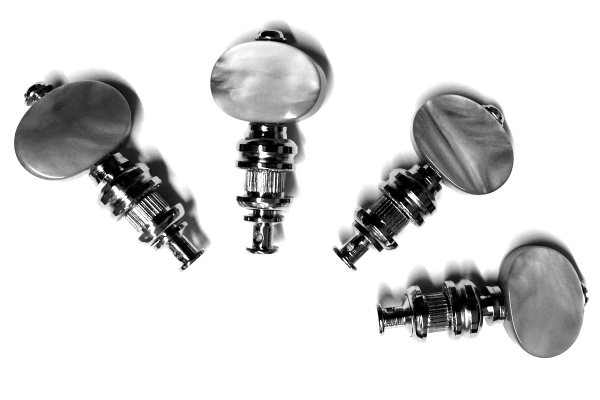
Conclusion
Phew, well there you have it. We took a deep dive into tuning all the banjo uke sizes, using electronic tuners, some history, various tuning topics, and some discussion on tuning parts.
It should only take a couple days of practice tuning your uke before it becomes second nature. If you want to speed up the learning process, try this: tune up your ukulele, then loosen all the strings and try tuning it again. Repeat until you feel you’ve got it down.
Hopefully we’ve covered whatever topic you were looking for. If not, feel free to leave a comment below and let us know what we missed!

the missing thing is in this nice and informative article: how do you tune a tenorbanjo to ukulele tuning:
this wil do:
string inches tone string type
1 0,025 G3 wounded, phosofor brons
2 0,016 C4 plain steel
3 0,012 E4 plain steel
4 0,009 A4 plain steel
Wow, didn’t even think of that. I’ll definitely have to add a section to the article for tuning a tenor banjo with ukulele tuning, but for now your comment covers the basics. Thanks!
Just read your post here. I have a question for you. What type of guitar tuner do you use? I’m deciding whether I want to get a clip on tuner or on the of plugin kind. I’d be using it on my acoustic, but the guitar has a pickup too. I appreciate the help.
I have a clip-on tuner, though I don’t really use it, and I’m not even sure where it is.
I usually just tune my C string to a source (electronic keyboard, etc.), then tune my other strings to that, out of habit.
As far as clip-on vs. plug-in:
The main advantage to a clip-on tuner seems to be its convenience. It’s a little more portable (no wire), easily switched between instruments, and you can quickly tune up between songs in a live performance situation.
The main advantage to a plug-in tuner seems to be its ability to filter noise if you’re planning on tuning in a loud/noisy environment.
The plug-in tuner is considered more accurate, but I think any decent quality, well-reviewed clip-on tuner shouldn’t really have issues with accuracy.
Hope that helps.
Love this informative article.
The additional piece on what gauge strings to use to convert a tenor banjo to uke tuning also caught my eye and made me think of what guage strings to use to convert my tenor banjo to baritone uke tuning ie low D, G, B, E.
This would be very useful to me.